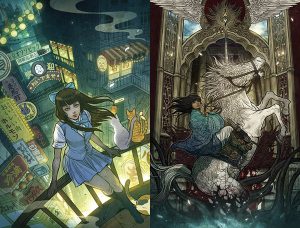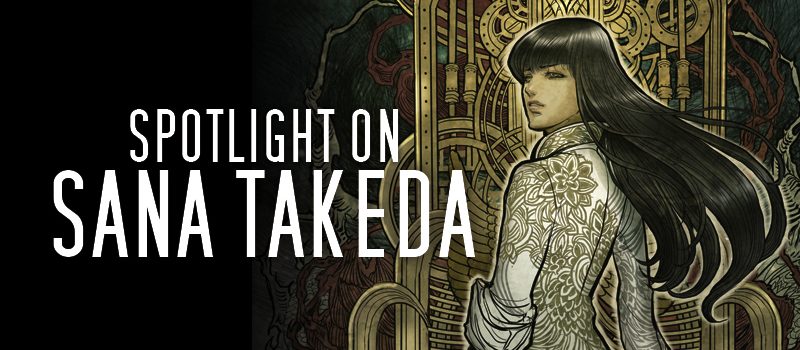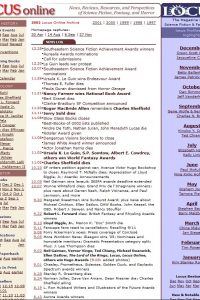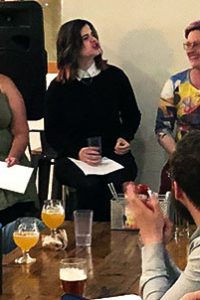Spotlight on: Sana Takeda

What was your introduction to the comics field? Who were your influences? Was there a particular artist or artists who drew you in?
You know a lot of talented artists in the field of comics. At first, I felt, ‘‘There is no room for me in this business.’’ I have not got any formal education in art and didn’t have special drawing skill. It was clear that, even if I spent hundreds of years, I could never catch up with those talented artists. I almost gave up finding my career in the comics industry. But fortunately some sketches of mine were found by an editor at Marvel. I don’t understand why that happened yet. Maybe I was just lucky.
As I said, I didn’t have special drawing skill, but always I said to myself, ‘‘What if I can find a niche which accepts me?’’ If I could find and challenge that niche with what I have already, there should be some room for me. What I have already is perspective I got as I grew up – Japanese culture, wonderful nature, and various other things. I wanted to see and create something unprecedented and irreplaceable.
 When illustrating Monstress, with author Marjorie Liu, you function as casting director, setmaker, costumer, worldbuilder, collaborator, and imaginative guide all in one. Were there any particularly challenging aspects, or ways the project changed you as an artist?
When illustrating Monstress, with author Marjorie Liu, you function as casting director, setmaker, costumer, worldbuilder, collaborator, and imaginative guide all in one. Were there any particularly challenging aspects, or ways the project changed you as an artist?
Illustrating Monstress is very challenging for me, but I really enjoy anything with big pressure.
You know Marjorie is a genius, and her imagination weaves an incredible story, so I have to pick up each word of hers carefully. I try to pick up everything she says, even the part which she does not say.
Our dialogue between word and art was always a living creature. Her words birth my new art, and I hope my art births her new words as well. I am always excited (and anxious a bit) because I have no idea where we will arrive with that unique dialogue.
Also, in Monstress there are many characters who find life hard to live. Maybe just like some of us today. Some readers might feel these characters speak to them and also listen to them. That is a very beautiful dialogue, isn’t it?
When I create characters, I do it from the inside by listening carefully to their quotes. I think that creating from the outside is boring. For me the most important thing is the inner person, and creating from inside. This is a dialogue between the characters and myself. My favorite moment is when various dialogues can bear many possibilities and create beautiful products beyond my expectations.
What projects are you working on outside of Monstress?
I cannot say yet, but I will announce a wonderful new project in the near future, and I hope you love it.
Do you sketch from life, or do you work most of it out in your head before putting it to the page?
For creating quality art I try to expand the drawers of my mind all the time. For that I cherish listening to a variety people carefully and expanding my imagination. Listening is the one of the most important things for creation. Listening deeply and polishing imagination bring us beyond our expectations.
Are you excited or concerned about the impact digital media and digital books might have on traditional crafts and the role of the artist? How do you use digital media in your own workflow?
My work is all digital. I am in Japan, far from the US, so digital tools and media help my work a lot. I cannot imagine my work without them.
But in fact, as a reader, I love and prefer traditional paper books, because paper books give my senses many good feelings. I also love secondhand books with notes written by previous owners. I enjoy imagining what others imagined.
I think digital and analogue should coexist, depending on the situation.
How do you keep things fresh for yourself and learn new techniques and improve your craft? Have there been any recent changes or discoveries in your art process, or do you feel settled?
Learning new techniques is important, but I think that the most important thing is polishing our power of imagination rather than learning some techniques, and that imagination should come from our own roots.
Through getting involved in various projects in the past two decades, I learned the importance of my own roots for creation.
When borrowing a foreign traditional design, we tend to just mimic the design, but some people love it and cherish that tradition, so I want to honor them. If I just mimic something, it disgraces them, so I try to use my roots instead, and make completely new creations by combining foreign traditional design and my own culture.
Combining our own roots and an encounter beyond your expectations can create something powerful. Whatever we start, we can never rise without our own roots.
I hope I can keep changing myself through many encounters with my own roots.
Sana Takeda is a Japanese Hugo and Eisner Award winning illustrator and comic book artist. After working as a designer at Sega Corp., she became a freelancer. While drawing for Marvel, she also creates illustrations for games and children books. Her representative work is comic series Monstress, with Marjorie Liu.
 While you are here, please take a moment to support Locus with a one-time or recurring donation. We rely on reader donations to keep the magazine and site going, and would like to keep the site paywall free, but WE NEED YOUR FINANCIAL SUPPORT to continue quality coverage of the science fiction and fantasy field.
While you are here, please take a moment to support Locus with a one-time or recurring donation. We rely on reader donations to keep the magazine and site going, and would like to keep the site paywall free, but WE NEED YOUR FINANCIAL SUPPORT to continue quality coverage of the science fiction and fantasy field.
©Locus Magazine. Copyrighted material may not be republished without permission of LSFF.








